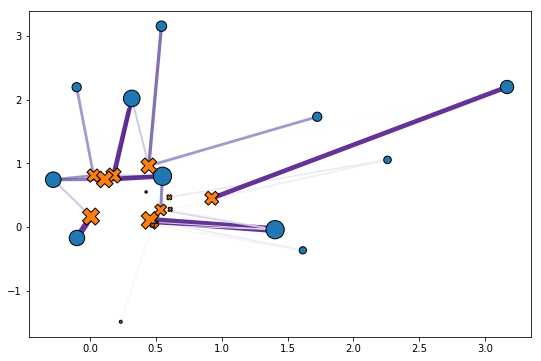See the full documentation.
A JAX powered library to compute optimal transport at scale and on accelerators, OTT-JAX includes the fastest
implementation of the Sinkhorn algorithm you will find around. We have implemented all tweaks (scheduling,
acceleration, initializations) and extensions (low-rank), that can be used directly, or within more advanced problems
(Gromov-Wasserstein, barycenters). Some of JAX features, including
JIT,
auto-vectorization and
implicit differentiation
work towards the goal of having end-to-end differentiable outputs. OTT-JAX is developed by a team of researchers
from Apple, Google, Meta and many academic contributors, including TU München, Oxford, ENSAE/IP Paris and the
Hebrew University.
Install OTT-JAX from PyPI as:
pip install ott-jaxor with conda via conda-forge as:
conda install -c conda-forge ott-jaxOptimal transport can be loosely described as the branch of mathematics and optimization that studies matching problems: given two families of points, and a cost function on pairs of points, find a "good" (low cost) way to associate bijectively to every point in the first family another in the second.
Such problems appear in all areas of science, are easy to describe, yet hard to solve. Indeed, while matching optimally
two sets of
Optimal transport extends all of this, through faster algorithms (in
In the simple toy example below, we compute the optimal coupling matrix between two point clouds sampled randomly (2D vectors, compared with the squared Euclidean distance):
import jax
import jax.numpy as jnp
from ott.geometry import pointcloud
from ott.problems.linear import linear_problem
from ott.solvers.linear import sinkhorn
# sample two point clouds and their weights.
rngs = jax.random.split(jax.random.PRNGKey(0), 4)
n, m, d = 12, 14, 2
x = jax.random.normal(rngs[0], (n,d)) + 1
y = jax.random.uniform(rngs[1], (m,d))
a = jax.random.uniform(rngs[2], (n,))
b = jax.random.uniform(rngs[3], (m,))
a, b = a / jnp.sum(a), b / jnp.sum(b)
# Computes the couplings using the Sinkhorn algorithm.
geom = pointcloud.PointCloud(x, y)
prob = linear_problem.LinearProblem(geom, a, b)
solver = sinkhorn.Sinkhorn()
out = solver(prob)The call to solver(prob) above works out the optimal transport solution. The out object contains a transport matrix
(here of size link strength between each point of the first point cloud, to one or
more points from the second, as illustrated in the plot below. We provide more flexibility to define custom cost
functions, objectives, and solvers, as detailed in the full documentation.
If you have found this work useful, please consider citing this reference:
@article{cuturi2022optimal,
title={Optimal Transport Tools (OTT): A JAX Toolbox for all things Wasserstein},
author={Cuturi, Marco and Meng-Papaxanthos, Laetitia and Tian, Yingtao and Bunne, Charlotte and
Davis, Geoff and Teboul, Olivier},
journal={arXiv preprint arXiv:2201.12324},
year={2022}
}





